-

新人教版高中英语选修2Unit 4 Using langauge-Listening教学设计
The theme of the listening section is " talking about scenery and culture along a journey."The part is designed to further lead the students to understand Canadian natural geography and social environment, and integrated into the cultural contrast by mentioning the long train journey from Beijing to Moscow routes. On this basis, the part activates students related travel experience, lets the student serial dialogue, guides the student to explore further the pleasure and meaning of the long journey, and Chinese and foreign cultural comparison.The part also provides a framework for the continuation of the dialogue, which is designed to provide a framework for students to successfully complete their oral expressions, and to incorporate an important trading strategy to end the dialogue naturally.1. Help students to understand and master some common English idioms in the context, and experience the expression effect of English idioms.2. Guide the students to understand the identity of different people in the listening context, and finish the dialogue according to their own experience.3. Instruct the students to use appropriate language to express surprise and curiosity about space and place in the dialogue, and master the oral strategy of ending the dialogue naturally.1. Instruct students to grasp the key information and important details of the dialogue.2. Instruct students to conduct a similar talk on the relevant topic.

新人教版高中英语选修2Unit 5 Learning about Language教学设计
The purpose of this section of vocabulary exercises is to consolidate the key words in the first part of the reading text, let the students write the words according to the English definition, and focus on the detection of the meaning and spelling of the new words. The teaching design includes use English definition to explain words, which is conducive to improving students' interest in vocabulary learning, cultivating their sense of English language and thinking in English, and making students willing to use this method to better grasp the meaning of words, expand their vocabulary, and improve their ability of vocabulary application. Besides, the design offers more context including sentences and short passage for students to practice words flexibly.1. Guide students to understand and consolidate the meaning and usage of the vocabulary in the context, 2. Guide the students to use the unit topic vocabulary in a richer context3. Let the students sort out and accumulate the accumulated vocabulary, establishes the semantic connection between the vocabulary,4. Enable students to understand and master the vocabulary more effectivelyGuiding the Ss to use unit topic words and the sentence patterns in a richer context.Step1: Read the passage about chemical burns and fill in the blanks with the correct forms of the words in the box.

新人教版高中英语选修2Unit 5 Reading and thinking教学设计
The theme of this activity is to learn the first aid knowledge of burns. Burns is common in life, but there are some misunderstandings in manual treatment. This activity provides students with correct first aid methods, so as not to take them for granted in an emergency. This section guides students to analyze the causes of scald and help students avoid such things. From the perspective of text structure and collaborative features, the text is expository. Expository, with explanation as the main way of expression, transmits knowledge and information to readers by analyzing concepts and elaborating examples. This text arranges the information in logical order, clearly presents three parts of the content through the subtitle, accurately describes the causes, types, characteristics and first aid measures of burns, and some paragraphs use topic sentences to summarize the main idea, and the level is very clear.1. Guide students to understand the causes, types, characteristics and first aid methods of burns, through reading2. Enhance students’ ability to deal withburnss and their awareness of burns prevention3. Enable students to improve the ability to judge the types of texts accurately and to master the characteristics and writing techniques of expository texts.Guide students to understand the causes, types, characteristics and first aid methods of burns, through readingStep1: Lead in by discussing the related topic:1. What first-aid techniques do you know of ?CPR; mouth to mouth artificial respiration; the Heimlich Manoeuvre

新人教版高中英语选修2Unit 3 Learning about Language教学设计
1. We'll need ten months at least to have the restaurant decorated.2.Some traditional Chinese dishes from before the Ming Dynasty are still popular today.3.My grandpa's breakfast mainly includes whole grain biscuits and a glass of milk.4.People in this area would eat nearly a kilo of cheese per week.5. We enjoyed a special dinner in a fancy restaurant where the waiters all wore attractive suits.6. He prefers this brand of coffee which, as he said, has an unusually good flavor.Key:1. at a minimum 2. prior to3. consist of4. consume5. elegant6. exceptionalStep 5:Familiarize yourself with some food idioms by matching the meaning on the right with the colored words on the left.1.Public concern for the health of farm animals has mushroomed in the UK2.Anderson may be young but he's certainly rolling to doing dough!3.George is a popular lecturer. He often peppers his speech with jokes.4.As the person to bring home the bacon, he needs to find a stable job.5 He is often regarded as a ham actor for his over emphasized facial expressions. The media reported that these companies had treated pollution as a hot potato. 6.The media reported that these companies had treated pollution as a hot potato.7.Don't worry about the test tomorrow. It's going to be a piece of cake!8. It's best to fold the swimming ring when it is as flat as a pancake.A. completely flatB. something that is very easy to do C.an issue that is hard to deal withD.to include large numbers of somethingE.to earn on e's living to support a familyF. wealthyG.to rapidly increase in numberH. an actor who performs badly, especially by over emphasizing emotions

新人教版高中英语选修2Unit 3 Reading for writing教学设计
The theme of this part is to write an article about healthy diet. Through reading and writing activities, students can accumulate knowledge about healthy diet, deepen their understanding of the theme of healthy diet, and reflect on their own eating habits. This text describes the basic principles of healthy diet. The author uses data analysis, definition, comparison, examples and other methods. It also provides a demonstration of the use of conjunctions, which provides important information reference for students to complete the next collaborative task, writing skills, vivid language materials and expressions.1. Teach Ss to learn and skillfully use the new words learned from the text.2. Develop students’ ability to understand, extract and summarize information.3. Guide students to understand the theme of healthy diet and reflect on their own eating habits.4. To guide students to analyze and understand the reading discourse from the aspects of theme content, writing structure, language expression, etc., 5. Enable Ss to write in combination with relevant topics and opinions, and to talk about their eating habits.1. Guide students to analyze and understand the reading discourse from the aspects of theme content, writing structure, language expression, etc.2. Enable them to write in combination with relevant topics and opinions, and to talk about their eating habits.3. Guide the students to use the cohesive words correctly, strengthen the textual cohesion, and make the expression fluent and the thinking clear.Step1: Warming upbrainstorm some healthy eating habits.1.Eat slowly.2.Don’t eat too much fat or sugar.3.Eat healthy food.4.Have a balanced diet.Step2: Read the passage and then sum up the main idea of each paragraph.

新人教版高中英语选修2Unit 3 Using langauge-Listening教学设计
1. How is Hunan cuisine somewhat different from Sichuan cuisine?The heat in Sichuan cuisine comes from chilies and Sichuan peppercorns. Human cuisine is often hotter and the heat comes from just chilies.2.What are the reasons why Hunan people like spicy food?Because they are a bold people. But many Chinese people think that hot food helps them overcome the effects of rainy or wet weather.3.Why do so many people love steamed fish head covered with chilies?People love it because the meat is quite tender and there are very few small bones.4.Why does Tingting recommend bridge tofu instead of dry pot duck with golden buns?Because bridge tofu has a lighter taste.5 .Why is red braised pork the most famous dish?Because Chairman Mao was from Hunan, and this was his favorite food.Step 5: Instruct students to make a short presentation to the class about your choice. Use the example and useful phrases below to help them.? In groups of three, discuss what types of restaurant you would like to take a foreign visitor to, and why. Then take turns role-playing taking your foreign guest to the restaurant you have chosen. One of you should act as the foreign guest, one as the Chinese host, and one as the waiter or waitress. You may start like this:? EXAMPLE? A: I really love spicy food, so what dish would you recommend?? B: I suggest Mapo tofu.? A: Really ? what's that?

新人教版高中英语选修2Unit 5 Using langauge-Listening教学设计
The theme of this section is to learn how to make emergency calls. Students should learn how to make emergency calls not only in China, but also in foreign countries in English, so that they can be prepared for future situations outside the home.The emergency telephone number is a vital hotline, which should be the most clear, rapid and effective communication with the acute operator.This section helps students to understand the emergency calls in some countries and the precautions for making emergency calls. Through the study of this section, students can accumulate common expressions and sentence patterns in this context. 1.Help students accumulate emergency telephone numbers in different countries and learn more about first aid2.Guide the students to understand the contents and instructions of the telephone, grasp the characteristics of the emergency telephone and the requirements of the emergency telephone.3.Guide students to understand the first aid instructions of the operators.4.Enable Ss to make simulated emergency calls with their partners in the language they have learned1. Instruct students to grasp the key information and important details of the dialogue.2. Instruct students to conduct a similar talk on the relevant topic.Step1:Look and discuss:Match the pictures below to the medical emergencies, and then discuss the questions in groups.
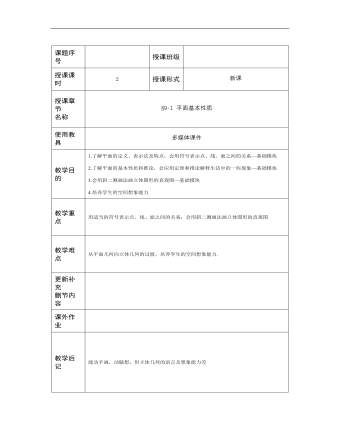
高教版中职数学基础模块下册:9.1《平面的基本性质》教学设计
课题序号 授课班级 授课课时2授课形式新课授课章节 名称§9-1 平面基本性质使用教具多媒体课件教学目的1.了解平面的定义、表示法及特点,会用符号表示点、线、面之间的关系—基础模块 2.了解平面的基本性质和推论,会应用定理和推论解释生活中的一些现象—基础模块 3.会用斜二测画法画立体图形的直观图—基础模块 4.培养学生的空间想象能力教学重点用适当的符号表示点、线、面之间的关系;会用斜二测画法画立体图形的直观图教学难点从平面几何向立体几何的过渡,培养学生的空间想象能力.更新补充 删节内容 课外作业 教学后记能动手画,动脑想,但立体几何的语言及想象能力差
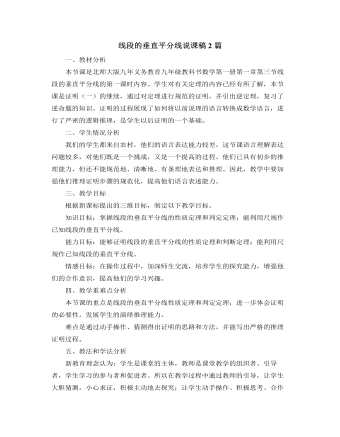
北师大版初中数学八年级下册线段的垂直平分线说课稿2篇
活动四:自主学习,尺规作图先阅读,再尝试作图,思考作图道理,小组讨论,“为什么作图过程中必须以大于1/2AB的长为半径画弧?”同桌演示尺规作图。最后折纸验证,使整个学习过程更加严谨。我将用下面这个课件给学生展示作图过程。再次回顾情境,让学生完成情境中的问题。(三)讲练结合,巩固新知第一个题目是直接运用性质解决问题,比较简单,面向全体学生。我还设计了第二个题目,想训练学生审题的能力。(四)课堂小结在学生们共同归纳总结本节课的过程中,让学生获得数学思考上的提高和感受成功的喜悦并进一步系统地完善本节课的知识。(五)当堂检测为了检测学生学习情况,我设计了当堂检测。第一个题目,让学生学会转化的思想来解决问题;第二个题目练习尺规作图。
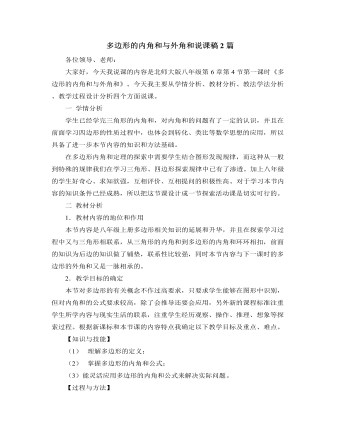
北师大版初中数学八年级下册多边形的内角和与外角和说课稿2篇
a.第127页随堂练习1第(1)题。b.一个多边形的边都相等,这是一个正多边形吗?c.一个多边形的内角都相等,这是一个正多边形吗?d.所以,一个相等,也都相等的多边形才是。(此检测主要是让学说出多边形和正多边形的定义,因为是在三角形、四边形的基础上,定义是一致的,所以不深究。在教材的处理上,把正多边形放在了前面,两个较为简单的概念放在一起,便于学生理解和掌握。)2.各组展示四边形的内角和的计算方法。3.各组展示五边形的内角和的计算方法。(由各组派代表上台板演,其它组补充,真正让学生动起来)4.各组选择前面最优的方法,口述六边形、七边形的内角和的算法。(以此上,学生可以利用对比的方法,选择作出过三角形的一个顶点的对角线的方法,让学生探索发现规律。)5.据此,你们认为n边形的内角和应该怎样计算。(注意n的条件)五、当堂训练。
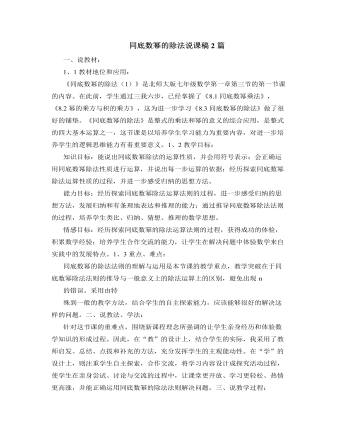
北师大版初中七年级数学下册同底数幂的除法说课稿2篇
设计意图:知识的掌握需要由浅到深,由易到难.我所设计的三个例题难度依次上升,根据由简到难的原则,先让学生学会熟悉选用公式,再进一步到公式的变形应用,巩固知识.特别是第三题特别强调了运用法则的前提:必需要底数相同.为加深学生对法则的理解记忆,形成“学以致用”的思想.同时为了调动学生思考,接下来让学生进入反馈练习阶段,进一步巩固记忆.4、知识反馈,提高反思练习1(1)口答设计意图:根据夸美纽斯的教学巩固性原则,为了培养学生独立解决问题的能力,在例题讲解后,通过让个别同学上黑板演演,其余同学在草稿本上完成练习的方式来掌握学生的学习情况,从而对讲解内容作适当的补充提醒.同时,在活动中引起学生的好奇心和强烈的求知欲,在获得经验和策略的同时,获得良好的情感体验.
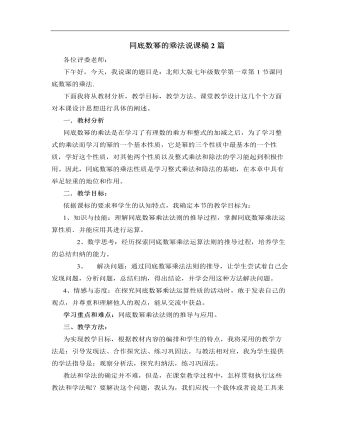
北师大版初中七年级数学下册同底数幂的乘法说课稿2篇
4、巩固新知,拓展新知(羊羊竞技场)本环节在学生对性质基本熟悉后安排了四组训练题,为避免学生应用性质的粗糙感,以小羊展开竞技表演为背景,让学生在轻松愉快的氛围中层层递进,不断深入,达到强化性质,拓展性质的目的。提高学生的辨别力;进一步增强学生运用性质解决问题的能力;训练学生的逆向思维能力,增强学生应变能力和解题灵活性.5、提炼小结完善结构(羊羊总结会)“通过本节课的学习,你在知识上有哪些收获,你学到了哪些方法?”引导学生自主总结。设计意图:使学生对本节课所学知识的结构有一个清晰的认识,能抓住重点进行课后复习。以及通过对学习过程的反思,掌握学习与研究的方法,学会学习,学会思考。6、课堂检测,发展潜能(大战灰太狼)
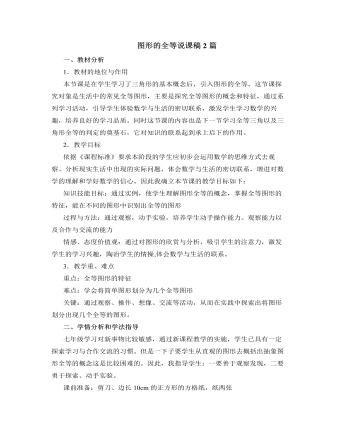
北师大版初中七年级数学下册图形的全等说课稿2篇
一、教材分析1.教材的地位与作用本节课是在学生学习了三角形的基本概念后,引入图形的全等。这节课探究对象是生活中的常见全等图形,主要是探究全等图形的概念和特征,通过系列学习活动,引导学生体验数学与生活的密切联系,激发学生学习数学的兴趣,培养良好的学习品质。同时这节课的内容也是下一节学习全等三角以及三角形全等的判定的奠基石,它对知识的联系起到承上启下的作用。2.教学目标依据《课程标准》要求本阶段的学生应初步会运用数学的思维方式去观察、分析现实生活中出现的实际问题,体会数学与生活的密切联系,增进对数学的理解和学好数学的信心。因此我确立本节课的教学目标如下:知识技能目标:通过实例,使学生理解图形全等的概念,掌握全等图形的特征,能在不同的图形中识别出全等的图形过程与方法:通过观察,动手实验,培养学生动手操作能力、观察能力以及合作与交流的能力
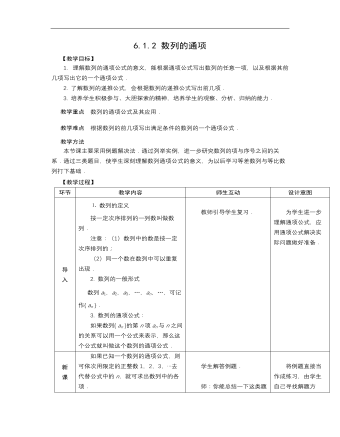
高教版中职数学基础模块下册:6.1《数列的概念》教案设计
【教学目标】1. 理解数列的通项公式的意义,能根据通项公式写出数列的任意一项,以及根据其前几项写出它的一个通项公式.2. 了解数列的递推公式,会根据数列的递推公式写出前几项.3.培养学生积极参与、大胆探索的精神,培养学生的观察、分析、归纳的能力.教学重点 数列的通项公式及其应用.教学难点 根据数列的前几项写出满足条件的数列的一个通项公式.教学方法 本节课主要采用例题解决法.通过列举实例,进一步研究数列的项与序号之间的关系.通过三类题目,使学生深刻理解数列通项公式的意义,为以后学习等差数列与等比数列打下基础.【教学过程】 环节教学内容师生互动设计意图导 入⒈数列的定义 按一定次序排列的一列数叫做数列. 注意:(1)数列中的数是按一定次序排列的; (2)同一个数在数列中可以重复出现. 2. 数列的一般形式 数列a1,a2,a3,…,an,…,可记作{ an }. 3. 数列的通项公式: 如果数列{ an }的第n项an与n之间的关系可以用一个公式来表示,那么这个公式就叫做这个数列的通项公式. 教师引导学生复习. 为学生进一步理解通项公式,应用通项公式解决实际问题做好准备.
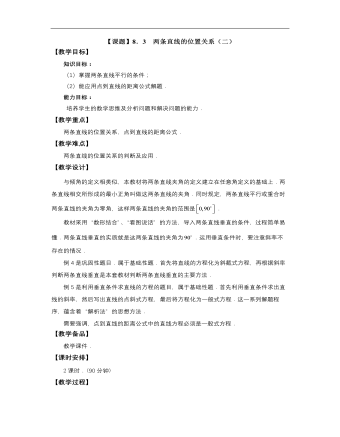
高教版中职数学基础模块下册:8.3《两条直线的位置关系》教案设计
教 学 过 程教师 行为学生 行为教学 意图 *揭示课题 8.3 两条直线的位置关系(二) *创设情境 兴趣导入 【问题】 平面内两条既不重合又不平行的直线肯定相交.如何求交点的坐标呢? 图8-12 介绍 质疑 引导 分析 了解 思考 启发 学生思考 *动脑思考 探索新知 如图8-12所示,两条相交直线的交点,既在上,又在上.所以的坐标是两条直线的方程的公共解.因此解两条直线的方程所组成的方程组,就可以得到两条直线交点的坐标. 观察图8-13,直线、相交于点P,如果不研究终边相同的角,共形成四个正角,分别为、、、,其中与,与为对顶角,而且. 图8-13 我们把两条直线相交所成的最小正角叫做这两条直线的夹角,记作. 规定,当两条直线平行或重合时,两条直线的夹角为零角,因此,两条直线夹角的取值范围为. 显然,在图8-13中,(或)是直线、的夹角,即. 当直线与直线的夹角为直角时称直线与直线垂直,记做.观察图8-14,显然,平行于轴的直线与平行于轴的直线垂直,即斜率为零的直线与斜率不存在的直线垂直. 图8-14 讲解 说明 讲解 说明 引领 分析 仔细 分析 讲解 关键 词语 思考 思考 理解 思考 理解 记忆 带领 学生 分析 带领 学生 分析 引导 式启 发学 生得 出结 果
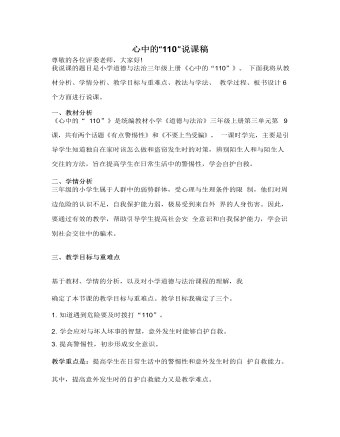
人教部编版道德与法制三年级上册心中的“110”说课稿
设计意图:不要轻信陌生人,防止上当受骗。 活动三:怎样与陌生人交往首先,学生阅读教材第 63 页的的小故事《智捉小偷》,教师引 导学生说一说陈宇遇事后的表现,自己如果遇到类似的情况会怎么处 理。然后,小组内先辨析教材第65 页四幅图中主人公的做法是否合 适,为什么?再说一说与陌生人交往的方法,全班汇报交流,教师相 机引导,板书:遇事情 多动脑。设计意图:学会与陌生人交往的方法,既不能把陌生人都当成坏 人,也要有一定的警惕性,要多动脑筋,用智慧保护自己。环节三:课堂小结,内化提升 学生谈一谈学习本节课的收获,教师相机引导。设计意图:梳理总结,体验收获与成功的喜悦,内化提升学生的认识与情感。环节四:回归生活,拓展延伸以小组为单位出一期板报,主题是与陌生人交往。设计意图: 将课堂所学延伸到学生的日常生活中,有利于落实行 为实践。
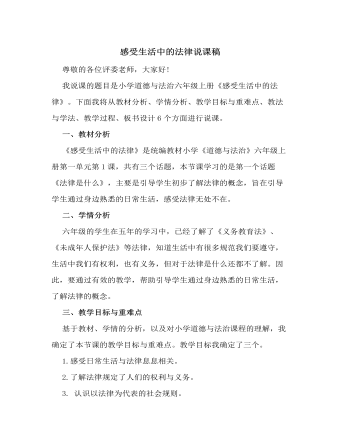
人教部编版道德与法制六年级上册感受生活中的法律说课稿
学生阅读教材第4页正文的文本,结合课前搜集到的纪律、道德与法律关系的相关资料,先在小组内讨论:你认为违反法律的后果和违反学校纪律的后果是一样的吗?再小组之间进行辩论,教师相机引导。板书:法律与纪律、道德等社会规范不同。设计意图:引导学生理解法律与纪律、道德等社会规范不同。环节三:课堂小结,内化提升学生谈一谈学习本节课的收获,教师相机引导。设计意图:梳理总结本节课的主要内容,体验收获与成功的喜悦,内化提升认识与情感。环节四:布置作业,课外延伸生活中,在行使权利的同时,履行好我们的义务。设计意图:将课堂所学延伸到学生的日常生活中,有利于落实行为实践。六、板书设计为了突出重点,让学生整体上感知本节课的主要内容,我将以思维导图的形式设计板书:在黑板中上方的中间位置是课题《感受生活中的法律》,下面是:法律是什么;学生说到的权利和义务;法律与纪律、道德等社会规范不同。
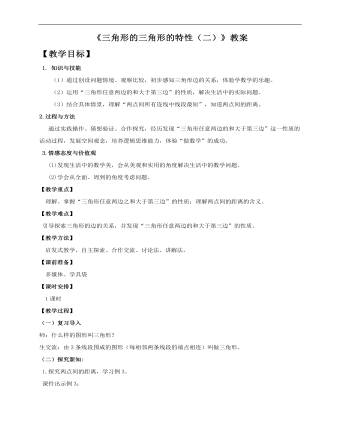
小学数学人教版四年级下册《第2课三角形的特性(二)》教案说课稿
2.过程与方法 通过实践操作、猜想验证、合作探究,经历发现“三角形任意两边的和大于第三边”这一性质的活动过程,发展空间观念,培养逻辑思维能力,体验“做数学”的成功。3.情感态度与价值观 (1)发现生活中的数学美,会从美观和实用的角度解决生活中的数学问题。 (2)学会从全面、周到的角度考虑问题。 【教学重点】 理解、掌握“三角形任意两边之和大于第三边”的性质;理解两点间的距离的含义。【教学难点】 引导探索三角形的边的关系,并发现“三角形任意两边的和大于第三边”的性质。【教学方法】启发式教学、自主探索、合作交流、讨论法、讲解法。【课前准备】多媒体、学具袋【课时安排】 1课时【教学过程】(一)复习导入 师:什么样的图形叫三角形?生交流:由3条线段围成的图形(每相邻两条线段的端点相连)叫做三角形。
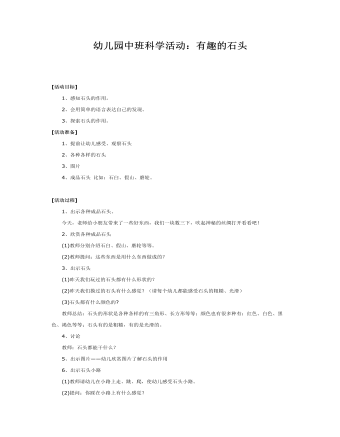
幼儿园中班科学教案:有趣的石头
2、会用简单的语言表达自己的发现。3、探索石头的作用。[活动准备]1、提前让幼儿感受、观察石头2、各种各样的石头3、图片4、成品石头比如:石臼、假山、磨轮。 [活动过程]1、出示各种成品石头。 今天,老师给小朋友带来了一些好东西,我们一块数三下,吹起神秘的丝绸打开看看吧!2、欣赏各种成品石头
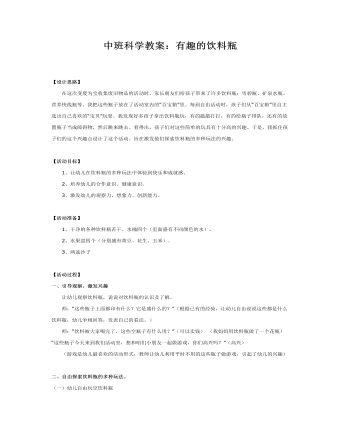
中班科学教案:有趣的饮料瓶
【活动目标】1、让幼儿在饮料瓶的多种玩法中体验到快乐和成就感。2、培养幼儿的合作意识、健康意识。3、激发幼儿的观察力、想象力、创新能力。 【活动准备】1、干净的各种饮料瓶若干、水桶四个(里面盛有不同颜色的水)。2、水果盘四个(分别盛有黄豆、花生、玉米)。3、两盆沙子 【活动过程】一、引导观察,激发兴趣 让幼儿观察饮料瓶,说说对饮料瓶的认识及了解。 师:“这些瓶子上面都印有什么?它是盛什么的?”(根据已有的经验,让幼儿自由说说这些都是什么饮料瓶,幼儿争相回答,发表自己的看法。) 师:“饮料被大家喝完了,这些空瓶子有什么用?”(可以卖钱)(我妈妈用饮料瓶做了一个花瓶)“这些瓶子今天来到我们活动室,想和咱们小朋友一起做游戏,你们高兴吗?”(高兴) (游戏是幼儿最喜欢的活动形式,教师让幼儿利用平时不用的这些瓶子做游戏,引起了幼儿的兴趣)

